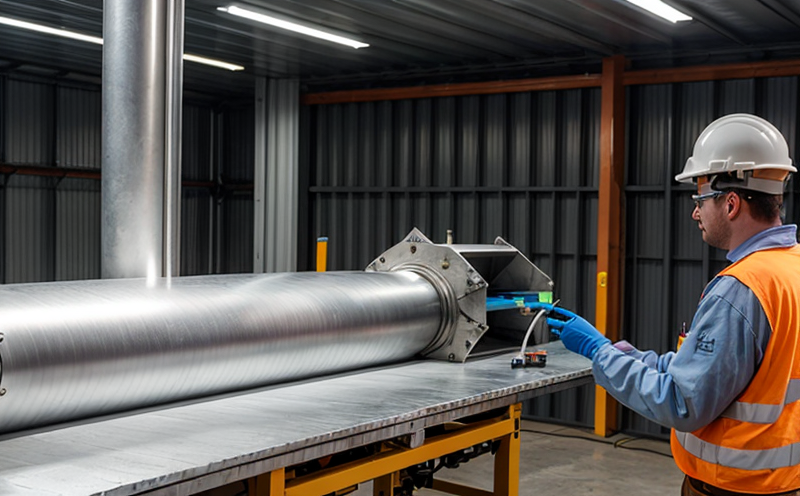ISO 148 Charpy Impact Testing of Renewable Component Metals
The ISO 148 standard provides a robust framework for conducting Charpy impact testing, which is critical in assessing the toughness and brittle fracture behavior of metallic materials. This service is particularly important for the renewable energy sector where the integrity and durability of components are paramount. The Charpy test measures the amount of energy absorbed by a specimen during fracture, offering valuable insights into material properties under dynamic loading conditions.
Materials used in renewable applications such as wind turbines, solar panels, and geothermal systems often operate in harsh environments and must withstand significant stress. Ensuring that these components meet stringent mechanical performance criteria is essential for their longevity and reliability. ISO 148 testing helps manufacturers identify potential weaknesses early in the development process, allowing them to refine designs and improve product quality.
The Charpy test involves not only a detailed understanding of the specimen preparation but also precise control over environmental factors like temperature and humidity. The standard specifies clear procedures for preparing specimens, ensuring they are representative of the material being tested. This includes considerations such as surface finish and dimensions that can significantly affect test results.
Instrumentation plays a crucial role in achieving accurate test results. Advanced impact testers equipped with sensors capable of capturing high-speed data provide precise measurements. These instruments must adhere to ISO 148 specifications, ensuring consistency across multiple tests. Reporting is equally important; detailed reports that include raw data and analysis are vital for quality assurance and compliance.
For materials used in renewable applications, the Charpy test can highlight issues such as residual stresses or heat treatments that may compromise material integrity. By identifying these flaws early, manufacturers can address them before production begins, leading to more reliable products. Additionally, ISO 148 testing supports the development of new materials and processes by providing a consistent benchmark for evaluation.
The Charpy test is not only useful in quality assurance but also contributes significantly to product development. Engineers can use the insights gained from these tests to optimize material composition and design features, enhancing overall performance and safety. The renewable energy sector benefits greatly from such testing, as it ensures that critical components meet the highest standards of reliability and durability.
| Standard Code | Description |
|---|---|
| ISO 148-1 | Method of testing metallic materials for absorbed energy in Charpy type impact tests - Part 1: General requirements and test methods |
| ASTM E23 | Standard Test Methods for Notched Bar Impact Testing of Metallic Materials |
Applied Standards
The ISO 148 series of standards provides a comprehensive approach to conducting Charpy impact testing, ensuring that the tests are both accurate and reproducible. These standards cover various aspects of the test, including specimen preparation, environmental conditions, equipment requirements, and data interpretation.
- ISO 148-1 outlines general requirements and basic procedures for performing Charpy impact tests on metallic materials.
- The standard specifies detailed guidelines for preparing specimens, ensuring they are representative of the material being tested. This includes considerations such as surface finish, geometry, and orientation.
Environmental and Sustainability Contributions
Charpy impact testing plays a crucial role in supporting environmental sustainability efforts by ensuring that materials used in renewable energy systems are robust and reliable. By identifying potential weaknesses early, this testing helps reduce the risk of failures in critical components, which can have significant environmental impacts.
- The Charpy test contributes to reducing waste through more informed design decisions, minimizing the need for replacement parts.
- By enhancing material durability and reliability, it supports longer operational lifetimes of renewable energy systems, leading to reduced greenhouse gas emissions and resource depletion.
Use Cases and Application Examples
The Charpy impact test is widely used across the renewable energy sector for various applications. It is particularly valuable in assessing materials used in wind turbine blades, solar panels, geothermal components, and other critical parts of renewable systems.
- Wind turbine manufacturers use ISO 148 testing to ensure that blade materials can withstand high-speed impacts without fracturing.
- Solar panel producers rely on this test to verify the toughness of glass substrates and structural components, ensuring they can endure harsh weather conditions.
These tests are also crucial for quality assurance in manufacturing processes. By identifying potential issues during development, manufacturers can refine their designs and improve product quality, leading to more efficient and sustainable renewable energy systems.





